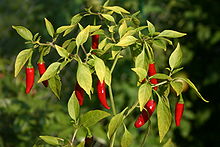Bird's eye chili
| Bird's eye chili | |
|---|---|

Several bird's eye chilis on a shrub
|
|
| Species | Capsicum annuum |
| Cultivar | Bird's Eye |
| Heat |
|
| Scoville scale | 100,000–225,000 SHU |
Bird's eye chili, bird eye chili, bird's chili or Thai chili is a chili pepper, a cultivar from the species Capsicum annuum, commonly found in Ethiopia and Southeast Asia. It is often confused with a similar-looking chili derived from the species Capsicum frutescens, the cultivar "siling labuyo". Capsicum frutescens are generally smaller and characteristically point to the sky. Bird's eye chili can also be found in India, particularly in Meghalaya, Assam, and Kerala. It is used in traditional dishes of the Kerala cuisine. This cultivar is also found in rural areas of Sri Lanka, where it is used as a substitute for green chilis. It is also a main ingredient in kochchi sambal, a salad made using freshly scraped coconut ground with bird's eye chilis and seasoned with salt and lime juice. It is used extensively in Thai, Malaysian, Lao, Khmer, Indonesian, and Vietnamese cuisine.
Some English speakers also refer to this cultivar as Thai hot, Thai dragon, and boonie pepper.
The bird's eye chili plant is a perennial with small, tapering fruits, often two or three, at a node. The fruits are very pungent.
The bird's eye chili is small, but is quite hot (piquant). It measures around 100,000–225,000 Scoville units, which is at the lower half of the range for the hotter habanero chili but still many times more spicy than a jalapeño.
Characteristics of the bird's eye chili plant
All chilis found around the world today have their origins in Mexico, Central America, and South America. They were spread by the Spanish and the Portuguese, together with many other now common crops such as maize, tomatoes and pineapples. This is now called the Columbian Exchange. The chili varieties found in Southeast Asia today were brought by Spanish and Portuguese colonists and traders in the 16th or 17th century.
...
Wikipedia
